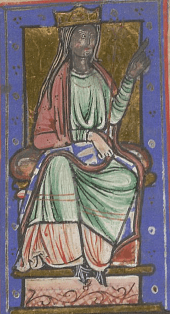Ealhswith
Ealhswith or Ealswitha (died 5 December 902) was the wife of King Alfred the Great. Her father was a Mercian nobleman, Æthelred Mucel, Ealdorman of the Gaini, which is thought to be an old Mercian tribal group. Her mother was Eadburh, a member of the Mercian royal family, and according to the historian Richard Abels she was a descendant of King Cenwulf of Mercia.[1] She is commemorated as a saint in the Christian East and the West on 20 July.[2]
| Ealhswith | |
|---|---|
 | |
| Reign | 23 April 871 – 26 October 899 |
| Died | 5 December 902 |
| Burial | |
| Spouse | Alfred, King of Wessex |
| Issue | Æthelflæd, Lady of the Mercians Edward, King of the Anglo-Saxons Æthelgifu Æthelweard of Wessex Ælfthryth, Countess of Flanders |
| Father | Æthelred Mucel |
| Mother | Eadburh |
Life
She was married to Alfred in 868 at Gainsborough, Lincolnshire. His elder brother Æthelred was then king, and Alfred was regarded as heir apparent.[3][4] The Danes occupied the Mercian town of Nottingham in that year, and the marriage was probably connected with an alliance between Wessex and Mercia.[5] Alfred became king on his brother's death in 871. Ealhswith is very obscure in contemporary sources. She did not witness any known charters, and Asser did not even mention her name in his life of King Alfred. In accordance with ninth century West Saxon custom, she was not given the title of queen. According to King Alfred, this was because of the infamous conduct of a former queen of Wessex called Eadburh, who had accidentally poisoned her husband.[6]
Alfred left his wife three important symbolic estates in his will, Edington in Wiltshire, the site of one important victory over the Vikings, Lambourn in Berkshire, which was near another, and Wantage, his birthplace. These were all part of his bookland, and they stayed in royal possession after her death.[4]
It was probably after Alfred's death in 899 that Ealhswith founded the convent of St Mary's Abbey, Winchester, known as the Nunnaminster. She died on 5 December 902, and was buried in her son Edward's new Benedictine abbey, the New Minster, Winchester. She is commemorated in two early tenth century manuscripts as "the true and dear lady of the English".[4]
Ealhswith had a brother called Æthelwulf,[4] who was ealdorman of western and possibly central Mercia under his niece's husband, Æthelred, Lord of the Mercians, in the 890s.[7] He died in 901.[8]
Children
Alfred and Ealhswith had five children who survived to adulthood.[4]
- Æthelflæd (d. 918), Lady of the Mercians, married Æthelred, Lord of the Mercians
- Edward the Elder (d. 924), King of the Anglo-Saxons
- Æthelgifu, made abbess of her foundation at Shaftesbury by her father
- Ælfthryth, Countess of Flanders (d. 929), married Baldwin II, Count of Flanders
- Æthelweard (d. c. 920)
See also
- House of Wessex family tree
References
- Keynes & Lapidge, Asser, pp. 77; 240–41; Abels, Alfred the Great, p. 121
- http://catholicsaints.info/saint-elswith, http://www.antiochian.org/node/19095
- Keynes & Lapidge, Asser, p. 77
- Costambeys, Ealhswith
- Williams, Ealhswith
- Keynes & Lapidge Asser, pp. 71–72, 235–236
- Hart, "Athelstan Half-king", p. 116
- Æthelwulf 21 at Prosopography of Anglo-Saxon England
Sources
- Abels, Richard (1998). Alfred the Great: War, Kingship and Culture in Anglo-Saxon England. Harlow, UK: Longman. ISBN 0-582-04047-7.
- Costambeys, Marios (2004). "Ealhswith (d. 902), consort of Alfred, king of the West Saxons". Oxford Dictionary of National Biography. Oxford University Press. doi:10.1093/ref:odnb/39226. Retrieved 25 October 2012. (subscription or UK public library membership required)
- Hart, Cyril (1973). "Athelstan 'Half King' and his family". Anglo-Saxon England. Cambridge University Press. 2: 115–144. doi:10.1017/s0263675100000375. ISBN 0 521 20218 3.
- Keynes, Simon; Lapidge, Michael, eds. (1983). Alfred the Great: Asser's Life of King Alfred & Other Contemporary Sources. Penguin Classics. ISBN 978-0-14-04440-94.
- Williams, Ann (1991). "Ealhswith wife of King Alfred d. 902". In Ann Williams; Alfred P. Smyth; D. P. Kirby (eds.). A Biographical Dictionary of Dark Age Britain. Seaby. ISBN 1 85264 0472.
External links
| Wikimedia Commons has media related to Ealhswith. |
| Regnal titles | ||
|---|---|---|
| Preceded by Wulfthryth? |
Consort of the King of Wessex 871–899 |
Succeeded by Ecgwynn or Ælfflæd |